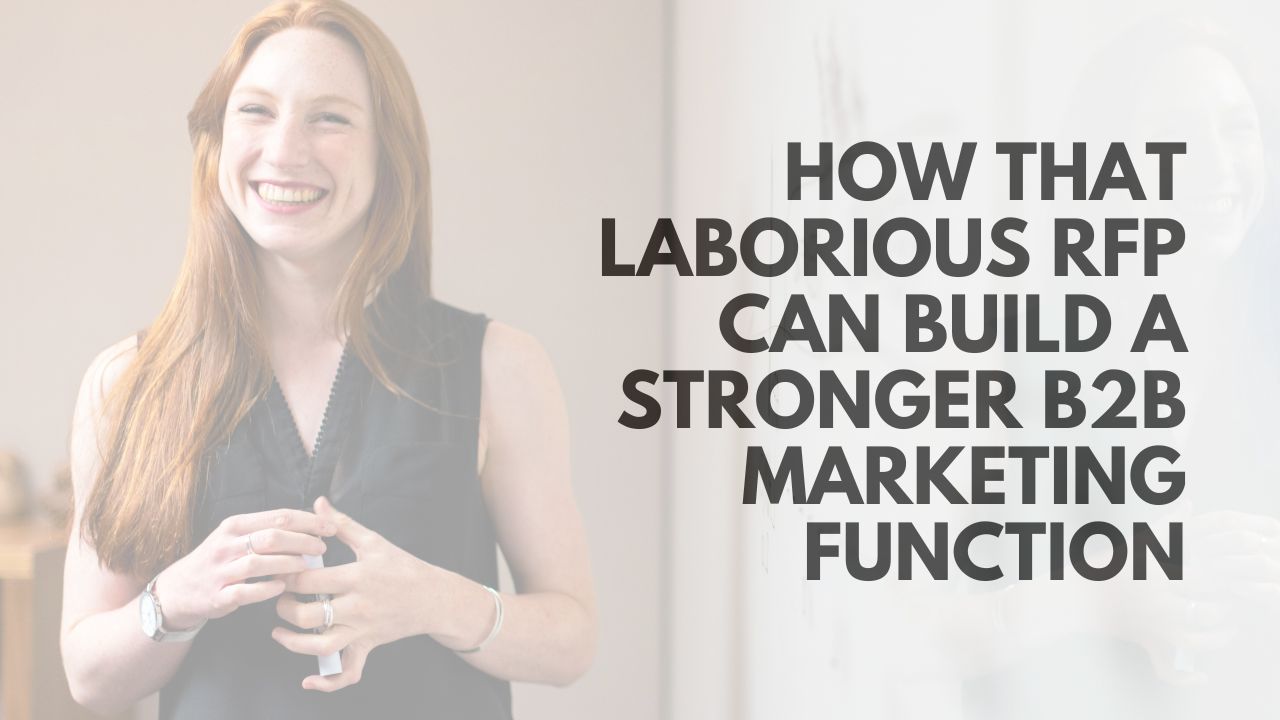The RYB newsletter is arriving in your inbox later than usual this week because I’ve been busy working on a request for proposal (RFP). The RFP process is an unavoidable part of the marketing industry, it seems, and it is the same for many of my B2B clients.
So I thought I’d capitalise on all that hard work and compile three pieces of RFP advice to help readers obviate the frustration and workload that comes with this much-maligned task.
Why marketing should be part of the RFP process
During my time as a marketing manager in property management, we saw a steep increase in the number of RFPs we had to complete. Since then, I’ve completed dozens on behalf of my own marketing services business as well as helped clients from a variety of industries and countries.
I think it is advisable to involve the marketing manager in the RFP process. The issuer of the RFP has likely been exposed to their marketing messages. So, it is logical to ensure that your answers to the RFP align with your B2B’s public image. Given that the marketing manager is responsible for coordinating this public persona, their involvement in the RFP team is essential to ensure consistency and coherence in communication.
We’re all familiar with the negatives of this type of work: you’re working ‘for free’, the vast majority of RFPs you complete won’t lead to new business, the RFP issuer asks the wrong questions etc. In addition, each new RFP that comes along seems to ask the same questions as the last but with slight differences that force you to entirely rewrite your previous answers. As an alternative, let’s look at three positives and the ways they can lead to building a better marketing function for your B2B.
RFP questions reveal valuable information about the issuer firm
This is especially so if the RFP was drawn up by a committee: you can practically read the power play struggles within the questions.
When a business issues an RFP, the questions it includes provide insights into its priorities, pain points, and expectations. For example:
- Questions about project goals and desired outcomes indicate the client’s strategic objectives and areas of focus.
- Inquiries about budget constraints offer insights into the client’s own financial situation.
- Questions about past experiences with similar projects or challenges reveal the client’s level of expertise
A bidder can gain a deeper understanding of a lead’s needs and strategic objectives. And that can inform future marketing campaigns.
Completing RFPs regularly forces you to keep business metrics up-to-date and accurate
Responding to RFPs requires businesses to gather and organize up-to-date, comprehensive records. This includes past project examples, client testimonials, financial data, ROI statistics and relevant credentials.
- Maintaining current financial records enables businesses to accurately assess their proposal’s pricing competitiveness
- Updating client testimonials and case studies helps businesses build a compelling narrative of their value proposition and how they differentiate themselves from competitors.
- Regularly reviewing and updating internal processes and resources ensures that businesses can effectively deliver on the promises made in their RFP responses.
It’s valuable data that can be used by your marketer in so many ways. Sometimes this data is not readily available, internally. But when an RFP is asking directly, it can give some leverage with management colleagues to bring that data out into the open. By stimulating a culture of record-keeping and data management, businesses can streamline their RFP response process and enhance operational efficiency.
RFPs reveal weaknesses in your offering that should be addressed
On the flip side to the last point, the RFP process acts as a mirror to your service; a critical self-assessment tool for businesses, highlighting areas where their offerings may fall short or need improvement.
Here’s how:
- Comparative analysis: Reviewing RFP requirements and evaluating competitors’ offerings can identify gaps in the business’s offerings compared to industry standards or best practices.
- Feedback mechanism: Client inquiries and feedback received during the RFP process provide valuable insights into areas where the business’s service may be perceived as lacking or deficient.
- Capability assessment: Assessing the feasibility of meeting RFP requirements exposes limitations in the business’s resources, expertise, or technological infrastructure.
Analyzing the strengths and weaknesses of your own RFP responses allows for introspection and identification of areas for improvement in messaging, positioning, or solution design. Businesses can proactively address weaknesses in their offerings, refine their value proposition, and enhance their competitiveness in the marketplace.

